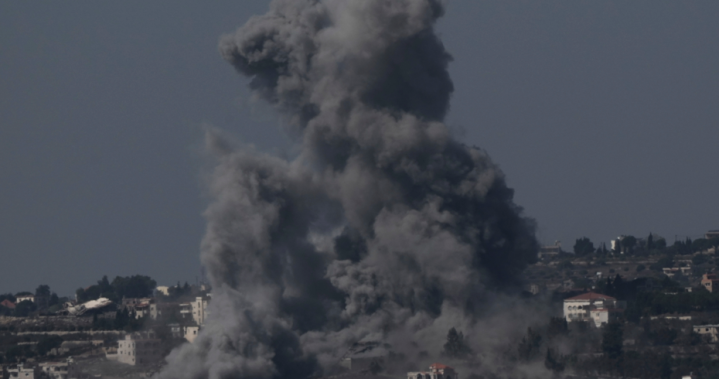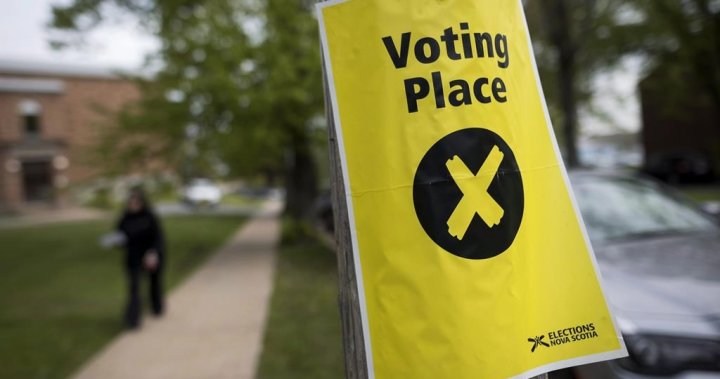Israel expands bombing in Lebanon as thousands flee widening war – National

New powerful explosions rocked Beirut’s southern suburbs on Saturday evening as Israel widened its bombing in Lebanon, also hitting a Palestinian refugee camp to the north for the first time, targeting both Hezbollah and Hamas fighters.
Thousands of people in Lebanon, including Palestinian refugees, continued to flee the region’s widening conflict, while rallies took place around the world in the run-up to the anniversary. from the start of the war in Gaza.
The loud explosions began around midnight after the Israeli army urged residents to evacuate areas of Beirut’s Haret Hreik, Choueifat and Burj el-Barajneh neighborhoods.
An AP video shows the explosions lighting up the densely populated southern suburbs, where Hezbollah has a strong presence. They followed a day of sporadic strikes and the almost continuous buzz of reconnaissance drones.
The Israeli military confirmed it was hitting targets near Beirut and said around 30 projectiles passed from Lebanon into Israeli territory, some of which were intercepted.
Earlier Saturday, the Israeli attack on the Beddawi camp in the north of the country killed an official from Hamas’s military wing as well as his wife and two young daughters, the Palestinian militant group said. Hamas later said another member of its military wing had been killed in Israeli strikes in eastern Lebanon’s Bekaa Valley.
The aftermath showed destroyed buildings, scattered bricks and stairs leading nowhere.
Israel has killed several Hamas officials in Lebanon since the start of the war between Israel and Hamas, in addition to most of the senior leaders of Lebanon-based Hezbollah, as fighting has sharply intensified.
At least 1,400 Lebanese, including civilians, doctors and Hezbollah fighters, have been killed and 1.2 million driven from their homes in less than two weeks. Israel says it wants to keep the militant group away from shared borders so that displaced Israelis can return home.
Iran-backed Hezbollah, Lebanon’s most powerful armed force, began firing rockets into Israel almost immediately after the Hamas attack on October 7, calling it a show of support for the Palestinians. Hezbollah and the Israeli army exchanged fire almost daily.

Receive national news daily
Get the day’s top news, politics, business and current affairs headlines delivered to your inbox once a day.
Last week, Israel launched what it called a limited ground operation in southern Lebanon after a series of attacks killed longtime Hezbollah leader Hassan Nasrallah and others.
The fighting is the worst since Israel’s brief war with Hezbollah in 2006. Nine Israeli soldiers were killed in ground clashes that Israel said killed 440 Hezbollah fighters.
Iranian Foreign Minister Abbas Araghchi told reporters in Damascus that “we are trying to achieve a ceasefire in Gaza and Lebanon.” The minister said that among the unnamed countries proposing initiatives are states in the region and some outside the Middle East.
Araghchi spoke a day after Iran’s supreme leader praised his recent missile strikes against Israel and said he was ready to do it again if necessary.
On Saturday evening, Israeli Prime Minister Benjamin Netanyahu said: “Israel has the duty and the right to defend itself and respond to these attacks, and it will do so. »
Regarding Lebanon, he said: “We are not finished yet.”
Flee Lebanon on foot
The Israeli army said on Saturday that around 90 projectiles were fired from Lebanon into Israeli territory. Most were intercepted, but several fell in the northern Arab town of Deir al-Asad, where police said three people were lightly injured.
At least six people in Lebanon were killed in more than a dozen Israeli airstrikes overnight and into Saturday, according to the Lebanese National News Agency.
Nearly 375,000 people have fled Lebanon to Syria in less than two weeks, according to a Lebanese government committee.
Associated Press journalists saw hundreds of people continue to cross the Masnaa border crossing on foot, crushing rubble after Israeli airstrikes left huge craters on the road leading there Thursday. Much of Hezbollah’s weaponry is believed to come from Iran via Syria.
“We were on the road for two days,” said Issa Hilal, one of many Syrian refugees in Lebanon who are now returning. “The roads were very busy…it was very difficult. We almost died when we got here. Some children were moaning or crying.
Other displaced families are now sheltering along Beirut’s famous seaside corniche, their tents flapping against the wind just steps from the luxury homes. “We don’t care if we die, but we don’t want to die at the hands of Netanyahu,” Om Ali Mcheik said.
The Israeli military said special forces were carrying out ground raids against Hezbollah infrastructure in southern Lebanon. It says troops dismantled tunnel shafts that Hezbollah used to approach the Israeli border.
More evacuation orders in Gaza
Nearly 42,000 Palestinians were killed in Gaza during the war, according to the Health Ministry, which does not differentiate between civilian and militant deaths. Nearly 90% of Gaza’s residents are displaced, amid widespread destruction.
Palestinian medical officials said Israeli strikes in northern and central Gaza on Saturday killed at least nine people. An incident in Beit Hanoun, in the north of the country, killed at least five people, including two children, according to the Gaza Health Ministry. Another hit a house in the Nuseirat refugee camp, killing at least four people, Awda hospital said.
The Israeli military made no immediate comment but has long accused Hamas of operating from civilian areas.
An Israeli airstrike killed two children in Gaza’s Zaytoun neighborhood, according to the civil defense first responder group that operates under the Hamas-led government.
The Israeli military has warned Palestinians to evacuate along the strategic Netzarim corridor in central Gaza, which is at the heart of obstacles to a ceasefire deal. The army asked residents in parts of the Nuseirat and Bureij refugee camps to evacuate to Muwasi, a coastal area they designated as a humanitarian zone.
It is unclear how many Palestinians are in these areas. Israeli forces have often returned to areas of Gaza to target Hamas fighters as they regroup.
© 2024 The Associated Press

















